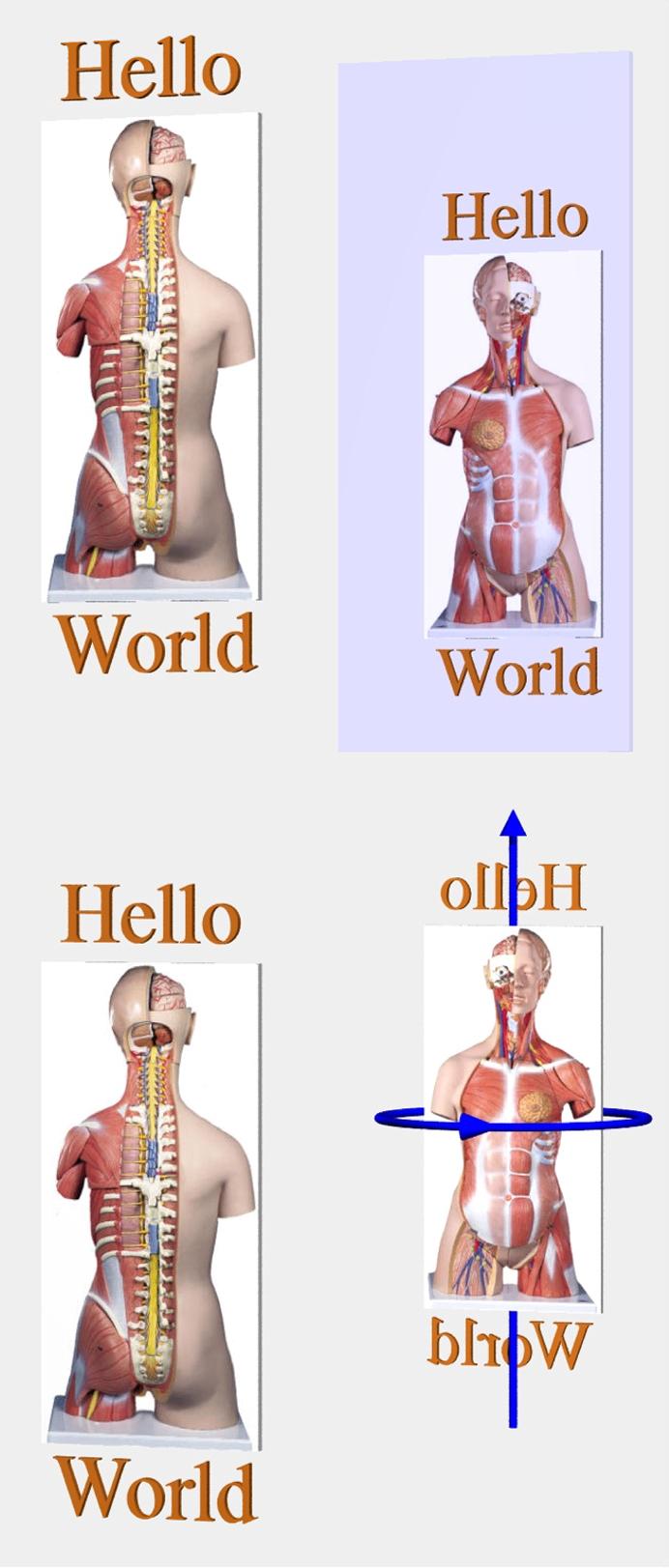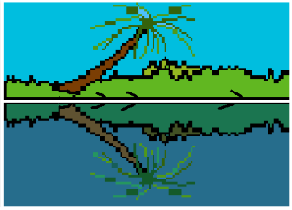Why is it that when you look in the mirror left and right directions appear flipped, but not the up and down?
-
52$\begingroup$ On which plane are your (2) eyes oriented? $\endgroup$– user4577Commented Jul 21, 2011 at 19:00
-
24$\begingroup$ And yet a lens turns the image upside down... $\endgroup$– DigikataCommented Jul 22, 2011 at 4:11
-
13$\begingroup$ a mirror does NOT inverse left/right, but "inside/out". It's even one of the FAQs (I liked the Usenet time where it was the only good source of info, updated by all, and therefore the FAQs at that time were great : faqs.org/faqs/physics-faq/part3 , question 20) $\endgroup$– Olivier DulacCommented Oct 3, 2013 at 16:48
-
31$\begingroup$ @user4577, "one-eyed" camera still sees left-right flip. $\endgroup$– alancalvittiCommented Dec 6, 2014 at 5:41
-
27$\begingroup$ @user4577 - If that were the answer then by tilting my head 90 degrees I could expert the mirror to start inverting vertically rather than horizontally. Only problem is, that doesn't happen. $\endgroup$– arothCommented Nov 27, 2015 at 1:26
28 Answers
Here's a video of physicist Richard Feynman discussing this question.
Imagine a blue dot and a red dot. They are in front of you, and the blue dot is on the right. Behind them is a mirror, and you can see their image in the mirror. The image of the blue dot is still on the right in the mirror.
What's different is that in the mirror, there's also a reflection of you. From that reflection's point of view, the blue dot is on the left.
What the mirror really does is flip the order of things in the direction perpendicular to its surface. Going on a line from behind you to in front of you, the order in real space is
- Your back
- Your front
- Dots
- Mirror
The order in the image space is
- Mirror
- Dots
- Your front
- Your back
Although left and right are not reversed, the blue dot, which in reality is lined up with your right eye, is lined up with your left eye in the image.
The key is that you are roughly left/right symmetric. The eye the blue dot is lined up with is still your right eye, even in the image. Imagine instead that Two-Face was looking in the mirror. (This is a fictional character whose left and right side of his face look different. His image on Wikipedia looks like this:)

If two-face looked in the mirror, he would instantly see that it was not himself looking back! If he had an identical twin and looked right at the identical twin, the "normal" sides of their face would be opposite each other. Two-face's good side is the right. When he looked at his twin, the twin's good side would be to the original two-face's left.
Instead, the mirror Two-face's good side is also to the right. Here is an illustration:
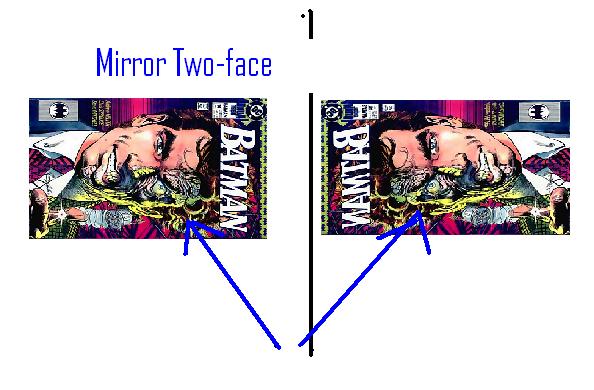
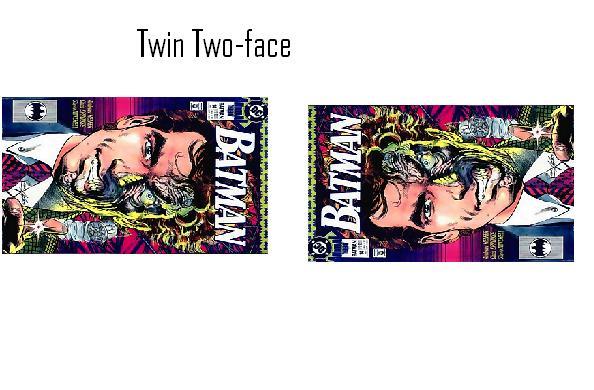
So two-face would not be confused by the dots. If the blue dot is lined up with Two-Face's good side, it is still lined up with his good side in the mirror. Here it is with the dots:
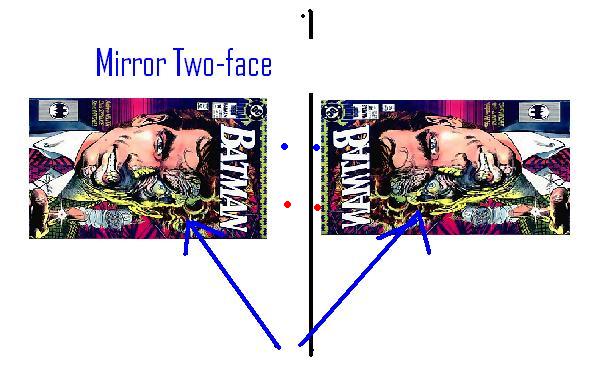
Two-face would recognize that left and right haven't been flipped so much as forward and backward, creating a different version of himself that cannot be rotated around to fit on top the original.
-
2$\begingroup$ See 1:56 of this video for a visualization of the axis reversal. $\endgroup$– LucasCommented Jul 22, 2011 at 2:43
-
40$\begingroup$ I just wanted to enhance this sentence of this answer because I believe it is the keypoint here: "What the mirror really does is flip the order of things in the direction perpendicular to its surface." $\endgroup$– cinicoCommented Sep 18, 2013 at 12:59
-
5$\begingroup$ @Mark-eichenlaub: simply said: A mirror does NOT inverse left/right, but it reverse the "Inside/Out". It's even one of the FAQs (I liked the Usenet time where it was the only good source of info, updated by all, and therefore the FAQs at that time were great : faqs.org/faqs/physics-faq/part3 , question 20) $\endgroup$ Commented Oct 3, 2013 at 16:50
-
1$\begingroup$ To add to this, I thought this video was the clearest explanation I've seen yet. $\endgroup$ Commented Jul 17, 2015 at 13:42
-
$\begingroup$ "Two-face would recognize that left and right haven't been flipped" But many people wouldn't. I think the correct answer is here: Why do mirrors flip horizontally and not vertically? We "see" horizontal rotation because it's common. $\endgroup$– User42Commented May 2, 2019 at 17:58
Because they don't flip left with right (or up with down), they flip the 3D space you're standing in "inside out", so far from the mirror becomes far away inside the mirror and vice versa. A hand 1 meter from the mirror seems like it's 1 meter on the other side of the mirror but in the same spot with regards to left/right so nothing is flipped.
Wiggle your left hand - you'll see the hand which is to the left in the mirror wiggle. Wiggle your toes and the toes in the mirror image wiggle etc.
-
35$\begingroup$ I was asked this question by a fellow Junior Fellow at Harvard who was convinced that it had to be the most important open question in early 21st century physics. ;-) By the way, there is one helpful twist. If you put a mirror on the ceiling above you, or the floor beneath you, it will reflect up and down, not left and right. Mirrors always reflect/exchange "in front of the mirror" and "behind the mirror". If we stand vertically, we just imagine that the person behind the mirror (the real image) is a real man and we rotate him by 180 degrees around the vertical axis. $\endgroup$ Commented Apr 7, 2011 at 20:48
-
11$\begingroup$ Once we rotate the man in the mirror by 180 degrees around the vertical axis. he looks like a normal man ready to shake our hand. But the rotation by 180 degrees was artificially added. If $z$ is up-down and $x$ is left-right and $y$ is front/rear of the mirror, then the mirror which is in the $xz$ plane maps $y\to -y$ and keeps $x,z$. However, we can easily imagine rotations around vertical axes to make the mirror man look like the original man. Such a rotation changes the signs of $x,y$, so the sign flip of $y$ is replaced by a sign flip of $x$ - but the real transform only affects $y$! $\endgroup$ Commented Apr 7, 2011 at 20:50
-
1$\begingroup$ I created/associated my account just to say that the first part of your explanation example (mirror on the ceiling) really clarifies well, you should post it as an answer! The second part is a little more unclear, actually. $\endgroup$– KzqaiCommented Apr 8, 2011 at 13:34
-
1$\begingroup$ You don't answer the question. $\endgroup$ Commented Oct 9, 2011 at 7:15
-
$\begingroup$ This is a flip along the (defined) Z axis direction, which if you stand in front of a mirror is defined as the direction from your eyes to the mirror. $\endgroup$ Commented Aug 20, 2015 at 15:06
This common confusion stems from our familiarity with photographs. We forget that we rotate them to face ourselves.
Take a picture of yourself and hold it up in front of you. Probably you are holding it so that you can see your image. If so, you "flipped" the image of yourself when you rotated it 180 degrees around the vertical axis. When you look to the left side of the photo, you are looking over the right shoulder of your image. These directions are flipped!
Now look in a mirror. When you look to the left, you are looking over the left shoulder of your image. These directions are not flipped!
Now pick up the picture again and turn it so it's facing the same direction you are facing. You have removed the 180 degree rotation so that you and your image are "looking" in the same direction. The left side of your image is again to your left. If the picture is transparent enough that you can see your image, you'll see not the back of your head, but your eyes, giving you the impression that you're looking back at yourself. A mirror image! But again, left and right are not flipped.
When you say the mirror "flips" left and right, you are speaking from the frame of reference of one who is used to the 180 degree rotation that you apply to view an opaque photograph. But that's what we all do because we consider photographs, rotated 180 degrees to face ourselves, as being the "correct" left-right orientation.
What a mirror really flips is the depth dimension. That which is behind you appears to be in front of you.
-
1$\begingroup$ Great answer! I just imagine a photon emitting from my right eye, bouncing off the mirror, and then returning to my right eye. Nothing "flipped" there. The eye in the photograph that's directly across (or closest to) my right eye is actually my left eye, because I've flipped the photograph 180 degrees from the original direction of the camera, just as if the photons on the mirror were somehow "frozen", and someone rotated the mirror 180 degrees to face them. $\endgroup$– webXLCommented Jul 21, 2011 at 20:55
-
4$\begingroup$ The simple example: Write a few words on a transparent piece of plastic of some sort, then hold it up in front of yourself while looking in a mirror. You can read the text just fine in front of you, or in the mirror. $\endgroup$– user952Commented Jul 22, 2011 at 1:12
-
7$\begingroup$ Exactly. A mirror does not flip left and right. It is we who imagine another person in the mirror and change our frame of reference by "flipping" it. When I first read about mirrors flipping things (I was probably four or five), I found it confusing because I looked at the mirror and nothing was flipped. (It was only later that I learned to do the flipping with photographs and other people -- before that, I'd use to speak of the right hand of someone facing me as the left hand, because it was indeed to my left.) $\endgroup$ Commented Dec 27, 2011 at 6:56
Take a picture and look at it. Now turn the picture to face the mirror. Question one: who flipped the picture? Answer: you did. Now, face the picture back to you, and walk to the nearest refrigerator. Turn the picture to face the refrigerator. Wow! Refrigerators flip images too! Don't believe me? Take your flipped page and hold it up to a bright light. The image is flipped; no mirror required.
Now, most people will turn a page around the vertial axis when they want to face it away from themselves. However, you could flip the page around any axis you choose, as long as it's in the plane of the page. You could easily, for example, flip the page around the horizontal axis. If you still believe that mirrors flip images, you'll notice that you've now tricked the mirror into flipping the image top-to-bottom, not left-to-right. Flip the page around a diagonal axis, and you'll get a very different result.
Bottom line: mirrors don't flip images; people do.
-
2$\begingroup$ Perfect explanation!!! It took me a long time to figure this out, b/c Feynman's inside/out translation explanation is so confusing. There is sorta/kinda a sense in which you could say that translation occurs, but ultimately it's irrelevant. It's not related to "flipping" at all. $\endgroup$ Commented Jan 13, 2017 at 17:58
It's easier with images... The mirror doesn't flip left and right as you can see in the upper image. The so-called flip occurs when somebody in the real world rotates ${180}^{\circ}$ about the vertical axis to see you face to face, as can be seen in the lower image.
Here's how I explain it (this is pretty similar to most of the other answers).
Assume the mirror is hanging vertically on a wall, and you're standing upright and facing it, looking at your own reflection. (Just to make the assumptions explicit.) And let's assume that you're facing north, and wearing a watch on your left wrist.
The mirror doesn't flip left and right; it flips forward and back. Your front is farther north than your back, but your reflection's front is farther south than its back. Your feet and the reflection's feet both face down. The wrist with the watch is on the west side, both for you and your reflection.
So why do we think that the mirror flips left and right? I think it's because we mentally map the (mathematically simple but physically awkward) transformation to something that makes physical sense. The "simple" front-to-back reversal is mentally mapped to (a) a 180-degree rotation (something that people do all the time), and (b) a left-to-right reversal (which people don't do, but since we're pretty much bilaterally symmetric, it doesn't seem as strange). So the person you see in the mirror looks like a normal person who happens to wear his watch on his "right" wrist and part his hair on the other side.
If we weren't bilaterally symmetric, we might see it differently.
For an example of what an actual front-to-back flip would look like, see this scene from Terminator 2; sorry about the background music, it's the only online video I've found of that scene.
-
1$\begingroup$ "If we weren't bilaterally symmetric, we might see it differently." If you hold something asymmetric in front of a mirror, like let's say some text, it still appears flipped horizontally. So that doesn't really explain it. $\endgroup$ Commented Jan 13, 2017 at 18:17
-
$\begingroup$ @industry7: It appears flipped horizontally to us. If we weren't bilaterally symmetric, we might think of it differently. To us, a left-to-right reversal seems natural, even though it's not physically plausible, because the result of the reversal still looks natural. To an intelligent being without that kind of symmetry, a left-to-right reversal might not seem any more natural than a front-to-back reversal. $\endgroup$ Commented Nov 17, 2018 at 22:03
-
$\begingroup$ I'm not sure if I really made my point. Just forget about the fact that humans are symmetrical for a second, and think about something that is inherently asymetrical. For example, hold some text in front of a mirror. It will be flipped horizontally, but not vertically. And this is not a matter of perception, an objective electronic device would register the text is indeed backwards. $\endgroup$ Commented Nov 20, 2018 at 19:06
-
$\begingroup$ @industry7: Sure -- but you're also looking at the other side of it. The transformation can be seen in (at least) two ways: (1) A reflection on a vertical plane combined with a rotation about a vertical axis, or (2) a single reflection about the plane of the mirror. You could also see it as (3) a reflection on a horizontal plane combined with a rotation about a horizontal axis. We tend to choose (1) because it's more physically plausible. $\endgroup$ Commented Nov 20, 2018 at 22:09
First, lets separate the concepts; there is nothing that is "flipped" in the mirror image regarding one orientation more than others. the full group of transformations $O\left(3\right)$ includes transformations where $\det{\left(R\right)} = -1$. You can consider the following transformations examples of this:
they have one random direction flipped in sign, or
for the special case where $D= 2n+1$, you can flip all direction signs.
Moreover, all these rotations are equivalent to each other, that is, any of them is equivalent to any other by a normal rotation $\det{\left(R\right)} = 1$.
Explained in other way, the mirror image is also equivalent to your image with up and down flipped. You only think in the equivalent with the right-left flipped version because its easier to build in your mind. That might be related with the fact that our bodies are almost right-left symmetrical, but very poorly up-down symmetrical.
Imagine a mirror placed on the floor. Your face, looking at it, will be pointed downwards; but the face "in the mirror" is "looking" up.
The other answers here are great — I just wanted to make sure we discard the assumption that the mirror is placed on a wall!
-
5$\begingroup$ a lake is much better, natural example, in this case. $\endgroup$– ariveroCommented Aug 3, 2011 at 16:33
Think about where a point above, below, left, and right of your point of view are in the reflection. Your head is still on top, your feet still on the bottom in the mirror. Likewise, your left hand is still to the left and your right hand to the right. It seems flipped because, to look behind you, you are used to turning around (which swaps left/right), rather than flipping (which swaps top/bottom). If we flipped upside down instead of turning around to see behind us, you would experience the opposite effect.
I can't resist: Here are two real experiments I came up with to explore the assertion that mirrors invert left-to-right but not up-to-down. Fans of the scientific method (and of Douglas Adams) know that the first step in any good experiment is to figure out exactly what the question (or hypothesis) really is. So, if you like having "obvious" assumptions shaken up a bit, please read on!
On an index card, write your name or some text in large block letters. Next, use one hand to hold it just in front of you as if it were a name badge at a meeting. With your other hand, hold a mirror in front of you so that you can read your "name badge." The text will look inverted left-to-right, as expected, while up-and-down looks normal, also as expected. Next, move the mirror upwards until it is straight above you, while tilting the bottom of the card out just enough so you can read it in the mirror. Result: You will still see the card text reversed left-to-right, as before. But think for a second: You are also seeing yourself standing on your head. That's top-to-bottom inversion, so you are getting both types of inversion at once! So, is the lack of vertical inversion really inherent in the mirror question, or have you just been holding the mirror in the wrong place all these years? And if so, why does the choice of where to place the mirror give one inversion in one case, and two in the other?
In the second experiment, hold the same card at arms length in front of you. Have it facing towards you this time so you an easily read it. Next, use your other arm to position a small mirror to the left or right of your line of sight of the card, and adjust the mirror until you can see the card in it. You will see the card text reversed left-to-right, just as with a face-on mirror. Now start moving the mirror in a circular arc until it is above the line of sight instead of to the left or right, keeping the reflected image of the card visible as you do so. When the mirror reaches the top, what do you see? Probably not what you expected: The text now has normal left-to-right order, but each letter is flipped upside down! In other words, the missing "vertical inversion" that everyone worries about in mirror experiments is right there in front of you. If you don't believe me, try it; there's no ambiguity in the effect. And if you want something more to ponder, try to figure out exactly when and how the vertical-is-normal, left-to-right-is-flipped image of the text transforms into the vertical-is-flipped, left-to-right-is-normal image during the rotation of the mirror. You can watch every step of the process as it occurs!
So, with these two experiments, it's worth asking: Is it really true that mirrors always reverse left-to-right? The earlier answer that references Feynman's video discusses this same point nicely, so be sure to look at that if you have not already. I'll likely comment more myself at a later time. But for now, I just wanted to provide a couple of easy, fast experiments you can try yourself, ones that may make you ponder just what the question really is. (The answer of course is 42 -- that much we already know!)
Left and right is relative to you only but not to the rest of your environment (including the mirror), but up and down is static for the whole environment including you and the mirror.
Try this:
Make a paper cut-out of the letter F (or any easy-to-cut-out letter which is different from its horizontally and vertically flipped images). Shade or mark one side of the cut-out to distinguish it from the other. Get a second piece of paper and write the same letter on it several times.
Hold the cut-out in front of you while standing in front of a mirror. The real cut-out and the image will both appear in the normal orientation, but (due to the shading/mark on one side) it will be obvious that the direct view and the mirror view show opposite sides of the same object.
Hold the paper in front of you so that you can read it normally. You won't be able to read it in the mirror - only the backside will be visible. Flip it so that you can read it in the mirror. Which way did you turn it? Chances are that you flipped the paper horizontally, and the letter now appears to be flipped horizontally. You could also flip it vertically, and the letter would appear to be flipped vertically.
The flipping came from you. All the mirror is doing is allowing you to see the opposite side of an object which is between you and the mirror. For the cutout, the opposite side has the same shape, so you don't do any flipping and the image appears normal. For the paper, the opposite side isn't interesting, and you have to turn the interesting side to face the mirror.
A more real-world situation is seeing a license plate in a mirror. I you want to instead view the license plate directly, either you must turn to face it (if it's behind you) or it must turn to face you (if it's in front of you). Both of these turns would typically be about the vertical axis, because it's hard to rotate your head or car about the horizontal axis.
All you have to do is imagine the line $y=x+1$ on the Cartesian plane. If you reflect the line across a mirror in the vertical direction (across the $y$-axis), then the line becomes $y=-x+1$. Therefore, a vertical mirror flips the line's horizontal coordinates.
However, if you reflect the lines across a mirror is in the horizontal direction (across the $x$-axis), then the line becomes $y=-x-1$. A horizontal mirror flips the line's vertical coordinates.
The mirror just flips the axis perpendicular to its orientation!
Because your eyes are set left and right and how you relate to the mirror.
When you turn a picture to reflect in a mirror, you usually turn it left or right. If you turned it vertically, the up and down reflection will be opposite, but left and right will still be the same.
-
4$\begingroup$ It also works with one eye. (although I agree with the second part of your answer) $\endgroup$ Commented Oct 9, 2011 at 7:10
-
$\begingroup$ The first sentence is not related, but the rest of the answer is 100% correct. $\endgroup$ Commented Nov 21, 2018 at 17:04
What if I say that the mirror doesn't flip left and right? You've heard it right the mirror doesn't do the flipping. As the above answers say the mirror shows what is right infront of it. It's you(we humans) who think it is flipping.
Let me get this in detail
Before we begin tell me ,
'What makes you think that the mirror flips your left and right?' and
'what image do you think the mirror flips? in the first place'
The second question is a follow up question of the first one.
To answer these questions you need a camera not just an ordinary camera an imaginary,invisible camera { i.e i(camera) i,as in x+iy not in iPhone (pun intended)}
Now take a picture of yourself (No!! not a selfie!!)with that camera at a distance x and at height of your eye from ground. What do you see? you will see a picture of 'beautiful you' in that picture with your left and right unswapped
Now place a mirror(a big one) facing you at a distance x/2 from you while you are standing still just the way you were. ( Now you know why I said, no selfie)
Now again with you still standing in the same position take a picture of the mirror with the cam exactly where your eye is (I know it's practically not possible but trust me this 'i' can do anything) what do you see in this photo now? You will see the same 'you' as beautiful as you were in the first pic but with your left and right swapped
Now you see that the image is a flipped left and right. (I guess you can answer the second question now) Now, your question is why didn't the camera flip the up and down, right? I'm getting there.
It's because of you. It's because you did something when you were taking the second pic. You must be thinking 'what did I do? I barely moved'
If you remember, After you have inserted the mirror, I've asked you take the second pic, how did you bring the cam from x to you and make it face the mirror?
You brought the cam to you with its lens still facing you and turned the camera around by 180 ° towards the mirror about the vertical axis (bringing camera to you and turning need not be in the same order) that's why the image is looking flipped left-right.
why did you turn it that way? why not about horizontal? Had you turned the camera 180 degrees about the horizontal axis we would have seen a vertically inverted photograph of you.
I hope you understand what turning about horizontal axis means.
When you turn the camera by 180° about horizontal the camera will face the mirror and the camera will be upside down
Remember:
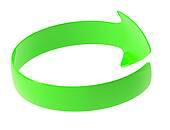 turning about vertical
turning about vertical
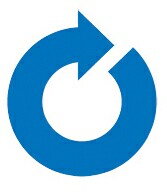 Turning about horizontal
Turning about horizontal
You took it for granted that the camera has to be turned that way only because it doesn't make any sense taking pics with upside down camera,It's like looking at the world with legs up and head down.Yes, nobody looks at it that way but that that's what makes the difference.
- To avoid confusion take another pic with camera facing the mirror and the camera is upside down. i.e turned 180° degrees about horizontal.
What do you see now? If you look at the pic in the camera It's again 'you', beautiful as ever but you are upside down i.e vertically inverted(you are also flipped left right but that another story, it's because we define left and right based on our top and bottom ), you'll notice it's not just you but also the whole world that is upside down.(Caution:Normal digital cameras and mobile cameras sometimes correct the orientation for you using gravity sensor and show upright image of you)
Still didn't get it? Thinking why the hell am I talking about this camera when we're taking about mirrors? It's not a camera it's your point of view. Getting back to the first question
What makes you think that the mirror flipped left and right?
Your took it for granted that your image is not vertically inverted. While taking the second pic I only asked you to make the camera face the mirror,I didn't tell you along which axis it should be rotated but you chose vertical axis only.
You assumed that you are not vertically inverted and asking why you are not vertically inverted.
But why are we all assuming that the image is flipped left right and why is it so hard to imagine that I'm vertically flipped even after being told? Well It's because when you flip your image horizontally your shape is almost the same except for your left is right. But when you flip vertically your shape is not retained. This is because our image is symmetric horizontally but not vertically.
Had we humans been vertically symmetric like in the image below (I know that some important organs are missing) it would have been easy for you to imagine that your are vertically flipped.

-
1$\begingroup$ I found this answer the most simple! $\endgroup$– surajckCommented Jan 19, 2018 at 9:28
-
$\begingroup$ Thanks for letting me know about it. It means a lot to me. $\endgroup$ Commented Jan 19, 2018 at 11:06
-
$\begingroup$ And one more thing. The biggest mind blow is when I realised that it's not just about vertical or horizontal we can turn but there are infinite number of ways in between them both. Infact we can choose any axis inclined to vertical ranging from 0° to180° and imagine that the image has been inverted along that axis. But fortunately only one of all the infinite axes make sense to our brain or else we'd be confused to death. $\endgroup$ Commented Jan 19, 2018 at 12:08
-
$\begingroup$ I was about to post the exact same answer before I found this. It is just gravity that defines how we rotate the object, not the mirror that rotates the image. $\endgroup$– SOFeCommented Aug 14, 2019 at 11:16
The mirror is not inverting the image in either direction but rather is acting like a rubber stamp doing a 1:1 transfer from surface to surface. If you wrote a word on a rubber stamp with fresh ink, then pressed the stamp to paper, the word on the paper would be backwards but not upside down. It's just a 1:1 transfer.
The simplest, but probably the only correct unswer is as follows:
"Left" and "Right" is determined WITH RESPECT TO "Up" and "Down".
Once you don't know what is "Up" (and/or "Down") you don't know what is "Right" and "Left". For instance, when you see only wheels of a car, but not it's top and bottom, you cannot say which tire is left and which is right.
Alternatively, one can identify Up (U) and Down (D) if he/she knows Right (R) and Left (L).
Hence, when you say that mirror "flips" R and L, you ASSUME that it does not "flip" U and D.
If you will assume that mirror does not "flip" R and L, you will come to conclusion that it flips U and D.
-
$\begingroup$ I was thinking the same.I think that mirror knows nothing about our posture,it is just us thinking that the image is flipped.But how can I explain it to someone who asks 'how can i think that mirror has not flipped the sides but turned upside down $\endgroup$ Commented Jun 8, 2015 at 10:29
-
1$\begingroup$ And why is it so easy to imagine that the mirror is flipping me left to right and it's so hard to apply the same to horizontal axis $\endgroup$ Commented Jun 8, 2015 at 10:56
-
1$\begingroup$ I've figured out how to do that.I've added an answer.Look at it bro $\endgroup$ Commented Jun 11, 2015 at 14:10
-
1$\begingroup$ I wrote this answer, which I think is still useful: The scene that we see "inside" the mirror is the "flipped" space outside the mirror. It appears that left and right are reversed, but it is just as accurate to say that up and down are reversed; we perceive the former because that transformation makes sense to us (mainly because gravity is in agreement with our intuition), while the latter does not. It would be equally accurate to say that the space is reversed through a diagonal plane at any arbitrary angle; it is reversed, that is all. $\endgroup$ Commented Nov 26, 2016 at 20:41
-
$\begingroup$ And Dale's answer, above, is also useful. $\endgroup$ Commented Nov 26, 2016 at 20:48
The accepted answer is fine, but there is something else I'd like to add to the discussion, a thought experiment that completely cleared up the question for me when I first thought of it.
As explained by others, mirrors just do what they do, they reflect light and that's it. So why is it that we have the impression that they flip us left-right, but not head-feet? This is because, in our heads, we compare the mirror image to what we would see if our "ghost" came out of our body, walked behind the mirror, and faced us. In this case, our head would face the ghost's head, our feet the ghost's feet, our left hand the ghost's right hand and our right hand the ghost's left hand. Whenever we meet another person face to face in real life, our body parts always face each other in this way.
Now imagine a world in which all of us were forced to lie on top of a skateboard, on our right side. Whenever you met a person face to face in this world, you would meet them with your head facing their feet, your feet facing their head, your left hand facing their left hand and your right hand facing their right hand. You would be used to this. Now comes the revelation: If, after living for a while in this world, you looked at yourself in the mirror, you would see yourself flipped head to feet, not left to right! This is because now you would be comparing the mirror image with your "ghost" coming out of your body, rolling on the skateboard while always lying on its right side, and ending up on the other side of the mirror with its head facing your feet and vice versa. The ghost's left hand would still face your left hand, and the same with the right hand.
So, the left and right flip is just a result of comparing our mirror image to the way we are used to seeing other people in front of us on Earth. One can conceive worlds whose inhabitants would perceive their mirror image as flipped top to bottom, or perhaps even other axes of symmetry if you made those worlds weird enough.
A mirror flips the image front to back, not left to right. In the mirror your nose is in front of your face, but in reality it should be behind your face. Because your image is flipped front-to back it just so happens to appear from our common sense perspective that left and right are actually flipped. The L-R flip is an illusion symptomatic of the front to back flip.
This makes sense from the perspective of symmetry groups however the wiki article on molecular symmetry groups is much more complete.
Rotation-reflection axis: an axis around which a rotation by $\tfrac{{360}^{\circ}}{n}$ , followed by a reflection in a plane perpendicular to it, leaves the molecule unchanged. Also called an $n$-fold improper rotation axis, it is abbreviated Sn. Examples are present in tetrahedral silicon tetrafluoride, with three S4 axes, and the staggered conformation of ethane with one S6 axis.
Essentially the front to back reflection is indistinguishable from a rotation.
-
$\begingroup$ True, but more explanation is needed (see Murod Abdukhakimov's explanation, which is made more clear with the addition of your explanation) $\endgroup$ Commented Nov 26, 2016 at 20:47
Mirrors flip in the dimension looking into/out of the mirror, not in the others. What changes left/right is what we present to the mirror. If you stand in front of another person, their right is on your left and vice versa, but their top is your top and their bottom is your bottom. That's not the mirror, that's convention for left/right.
If you stand in front of a mirror and there's an object behind you on your right, if you look in the mirror it's also to the right of the reflection of you.
Check out especially the demonstration with the arrow in this video:
https://www.youtube.com/watch?v=vBpxhfBlVLU
(Embedded videos are apparently not yet available on this site).
The mirror reflects things from back to front and I think other answers explain that better than I could but I wanted to add an insight that a teacher once shared with me. It has stuck with me for years.
When we think the reflection is reversed left to right we are assuming the reflection got to the other side by moving around the side of the mirror while continually facing us. That is what most of us would probably do if we were a reflection, but there is another way. The reflection could go over the top. If it did that (while continually facing us) we would be looking at its feet. Up and down would be reversed, but left and right would not.
This my second answer to this question. I felt like writing a new one Instead of editing the old one because this a completely new approach and is way more simpler.
It all comes from how we define left and right and that mirror changes the direction in whic the object is facing when by inverting the Z-axis. We assume that the ponits on vertical axis, since it seperates the left and right, remain unchanged after mirroring, we can draw a similar axis between any two points and say that the mirror has flipped along that axis.
Mirror does nothing apart from inverting the Z-axis, as Feynman said. Each point on your body that is facing the mirror will remain with the same X and Y coordinates(or to say in simple language, image of each point is right in front of the actual point). Mirror doesn't differentiate any points as in such. The asymmetry arises from our definition of left and right, here's how we try to find out which part of an object is the right and which is left.
Step 1: I start by drawing a hypothetical line between what I assume are the top and bottom of the object.
Step 2: Then, I orient myself(hypothetically) along that axis and face in the same direction as that(I assume) the object is facing.
Step 3: Now, whichever half of the object contains the right half of the body, I call it the right side of the object, and whatever is 'left' (some clever pun by the author), I call it as the left side of the object.
When I see the reflection of the object in the mirror all the points (including top, bottom, left and right most points) are exactly in front of each other but the direction the object is facing has changed by 180°, Owing to the Z-axis inversion by mirror as Feynman said. This is where it all happened!!! Now that the image is 'facing' the opposite direction to the actual object, I’ll have to position myself facing opposite direction to what I did earlier in step 2, This means in step 3, I’ll find what earlier was to my right will be on the left and vice-versa and hence the right and left of the image appear to be swapped (Recall the PET classes when we as kids, used to confuse left and right beacuse our instructor in front is facing you and his 'left' is your 'right'). When we drew the axis we assumed that the points along the axis remained even in the image and everthing else is swapped along it. But in truth all points remained at the same place(Only Z inversion happened), Infact If I draw this line(which seperates right and left of a body), between any other two points and call the two halfs obtained as left and right, It'd appear that all the points on that axis remained at the same place and the inversion happened along the new axis.
If it is still confusing you, let’s see how we can swap our top and bottom as opposed to left and right just by redefining ‘left’ and ‘right’.
I draw a horizontal axis between the right most part of the object and left most and repeat step 2 with my head at the right most part of the object, this means what was the 'up'per half of the object earlier will now be the 'left' half and what was the 'bottom' half will be the 'right' half. On looking at the the mirror image and and repeating step 2 and 3 assuming that the ponits along the the new axis remained same, It would tell me that the new left and right (the former 'up' and 'down') have been swapped.
There are two posibilities You can show your real forehead from the position of the mirror image of your forehead: by rotating your body up-down or left-right by 180°. All you see then is the real you and the mirror image symetric horizontally or in the second case symetric vertically. When we compare a real person and the image we don't take in account that a person could rotate to show to somebody in two different ways:the easy one(left-right) and the more complicated one(up-down) ...
It is surprising how long and convoluted the answers to this question are. It has to do with the fact that the question is not trivial. Some of the answers complicate matters by bringing depth to the discussion, which, in my opinion, should be kept separate or not brought into discussion at all.
A mirror does not flip a planar image either horizontally or vertically. The mirror produces a 'true image' of the planar image. Here, we define 'true image' as the image that you will perceive if you were able to somehow penetrate through the back of image, for example, in the case of a painting on a piece of paper. So the question now is, why does the image appear horizontally flipped to you when seeing in a mirror?
Let's say you have a painting on a piece of paper in your hand. You see the painting and your friend comes along and you want to show the painting to them. They stand in front of you, facing you. They are horizontally flipped with respect to you. (Mind you, they are not vertically flipped with respect to you, because none of your friends will come to talk to you on a hand-stand.) So to show the painting to your friend, you will have to flip the painting horizontally (and not vertically) so they see the same painting that you were seeing just a while ago. Now imagine you did the same in front of a mirror and not your friend. You basically present to the mirror a horizontally flipped painting. The mirror shows exactly what you present to it, and hence you see the painting as flipped.
A second example is your T-shirt. When you wear a T-shirt, you actually horizontally flip the T-shirt (and not vertically) when you wear it. You do that because anyone who comes to meet you face to face will be able to read what you were able to read when you bought the T-shirt. So basically you and your friends see the same thing since you present a horizontally flipped version of your T-shirt to your horizontally flipped friends. But when you see in the mirror, the mirror catches the horizontal flip and shows you a 'mirror image'.
Finally, when we look at ourselves in the mirror, we are actually looking at our 'true images'. However, our true images appear horizontally flipped to any friend who is standing face to face with us. In that sense, what we see of ourselves in the mirror, is a horizontally flipped version of what our friend will see of us when standing face to face!
Indeed, a scene can be flipped "up-and down" using a mirror; if you place horizontally the mirror at bottom of the scene.
However, the image will not be the same with actual-object (if we go through only rotations and translation), if the object is "chiral" Chirality is a sort of 3-dimensional assymmetry .
https://en.wikipedia.org/wiki/Chirality
"I call any geometrical figure, or group of points, 'chiral', and say that it has chirality if its image in a plane mirror, ideally realized, cannot be brought to coincide with itself." ... Lord Kelvin.
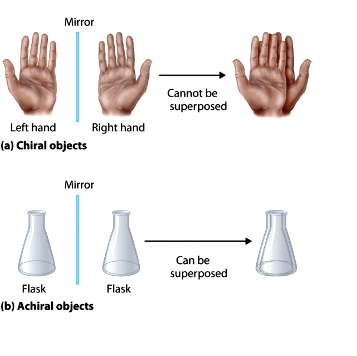 (actual file URL: http://chem.libretexts.org/@api/deki/files/54210/=122a3121b7268f235234e7a9091fc4ea.jpg?revision=1).
(actual file URL: http://chem.libretexts.org/@api/deki/files/54210/=122a3121b7268f235234e7a9091fc4ea.jpg?revision=1).
(the term chiral came from Greek, χειρ (kheir) = hand).
Its a geometric property.
For a chiral shape, only 2 "Enantiomorph" found. It and its mirror-shape.
(however I don't know any geometric proof about why a chiral object have only 1 other enantiomorph (mirror image); where-ever we keep the mirror.)
Now, we get our flipped-image (left exchanged to right) of our body, because our body is chiral; and that chirality (a sort of asymmetry) exist in left-right direction of our body. If we had that-sort of asymmetry in our up-down direction, we would get our mirror-image different in up-down (after rotations and translations). (our up and down is also asymmetric, so when we stand on a shiny floor, we could found our-bottom (legs) is not same with the image's bottom (which is head); but if we try to superpose the 2 images, the difference come in left and right). That means mirror changes left-right direction... that is due to our body-construction; not the mirror. . If that hypothetical condition happened; we probably didn't called this geometric property as "chirality". Probably we would called it as "updowny" or such.
Our left and right side are asymmetric?
In-fact we often felt difficulty to discover the change in mirror, because apparently we are achiral (since our left side is "apparently" a mirror-image of our right, tied together, so it contains a plane of symmetry (plane-of reflection), whose existence is a condition for achirality ); the flipping becomes quite visible if we have certain birthmark in one side, that make us more asymmetric.
But our left side and right side is not completely mirror image of each-other. We can sense our left and right separately. We can move our left and right hand separately.
It's about coordinate systems and about a false claim in the question.
The mirror doesn't flip. You see your right hand to your right, up towards up (in the global sense).
When we look at a picture of ourselves, we still see the object's left most (in the global system) hand to our left. Again nothing is actually flipped (in the global system).
But in the deceptively posed question we are using the local system of the object (e.g. my actual right hand) hand as a comparison. Since the local systems of observer (same as global) and image (opposite to global) are opposite, the object appears flipped.
There is no problem with up/down, since observer and image have the same up/down direction, which also happens to coincide with the global.
The mirror inverts the z-axis (the connection line from you to the mirror), not the x- and y- axis ("left/right", "up/down"). You still see your left hand when looking on the left in the mirror, and your feet are still on the floor in the mirror.
The reason that images are always flipped in a horizontal axis in flat surfaces (standard mirrors, water's surface, etc) is because you have two eyes, one which is situated left of the other rather than to the right. If you had one eye, or eyes situated in a different configuration, the optical effects would be different.
Note also that the brain performs a double-transform correction to the image you observe since the way your eye works is very similar to a converging lens with the image beyond the focal point. That is, just like normal lenses, the image appears inverted (in both vertical and horizontal axes).
-
$\begingroup$ Chirality is property of the object, not the perspective (how we're looking). For example, our left and right hand are mirror-image of each-other, and non-superposable (so non-identical shapes) . If an object is chiral, having a certain configuration (out of 2), (say our left hand), would remain like that, and an object having its opposite configuration (say our right hand), would remain like that. So I didn't find any relation with number-of eye (2 or 1) and distinguishing opposite chiral figures. also if I close one eye the situation remains the same. $\endgroup$– user115953Commented Jul 26, 2016 at 17:32

